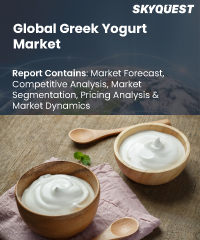
Report ID: SQMIG30I2272

Report ID:
SQMIG30I2272 |
Region:
Global |
Published Date: March, 2024
Pages:
198
|
Tables:
118 |
Figures:
77
Greek Yogurt Market Drivers
Increasing consumer recognition of its health benefits
One of the primary drivers behind the growth of the Greek yogurt market is the inherent health benefits it offers. Greek yogurt has gained increasing popularity among consumers due to its diverse nutritional advantages compared to regular yogurt. The current surge in demand for protein-rich products is a notable trend, as these items are known to provide a sense of fullness, stabilize blood sugar levels, and promote the development of lean muscle, ultimately facilitating fat loss.
Consequently, the consumption of Greek yogurt is anticipated to experience rapid growth, given its higher protein content relative to conventional yogurt. Additionally, numerous studies have highlighted that Greek yogurt contains reduced levels of lactose. This reduction is attributed to the multiple straining processes involved in its production, which removes whey and imparts a distinctive creamy texture while significantly reducing lactose content. Consequently, Greek yogurt stands as a preferable choice for individuals seeking lower lactose content in their dietary choices.
Influenced by shifting consumer preferences toward healthier and nutrient-rich food products
The Greek Yogurt Market is significantly influenced by shifting consumer preferences toward healthier and nutrient-rich food products, coupled with a heightened awareness of health among consumers. Greek yogurt's popularity has surged due to increasing demand for fat-free and weight-management products, particularly in the United States, Mexico, Canada, and other regions, where it is used in meal preparation and enjoyed as a sweet snack when paired with fruits. Within the food and beverage industry, Greek yogurt is frequently employed as a substitute for ingredients like butter, cream cheese, sour cream, and in the creation of smoothies and creams.
Furthermore, the market's growth is propelled by the introduction of Greek yogurt made from natural and organic ingredients, aligning with consumer preferences for gluten-free, chemical-free, and natural food sources. Other factors, such as urbanization, a growing middle-class population, and the rapid expansion of online sales, contribute to the overall increase in revenue within the Greek yogurt market.
Greek Yogurt Market Restraints
Price Sensitivity
Our industry expert will work with you to provide you with customized data in a short amount of time.
REQUEST FREE CUSTOMIZATIONWant to customize this report? This report can be personalized according to your needs. Our analysts and industry experts will work directly with you to understand your requirements and provide you with customized data in a short amount of time. We offer $1000 worth of FREE customization at the time of purchase.

Report ID: SQMIG30I2272